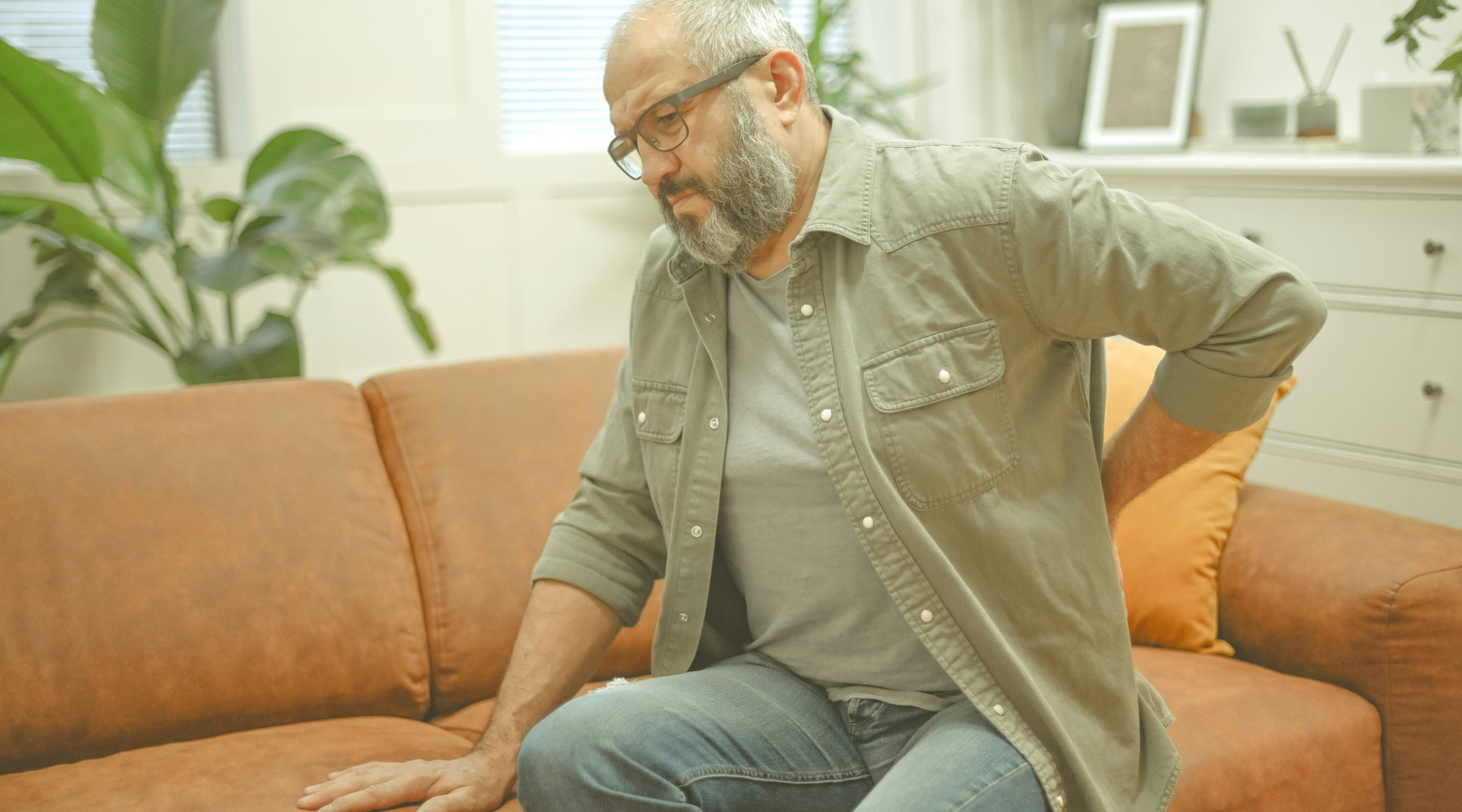Sciatica is a condition characterised by the irritation or compression of the sciatic nerve, which extends from your lower back down to your feet. This nerve plays a crucial role in transmitting sensory and motor signals to and from the lower limbs. While most cases of sciatica resolve within 4 to 6 weeks, it is possible for the symptoms to persist for a longer duration. The discomfort experienced can vary from mild to severe, often accompanied by pain, tingling, or numbness along the affected leg. Seeking appropriate medical attention and implementing targeted treatments can help alleviate the symptoms and promote a quicker recovery.
However, many people confuse sciatica with regular lower back pain, leg discomfort, or radicular leg pain. Proper diagnosis is necessary to find out the actual condition and ensure appropriate and timely treatment.
If you suffer from this debilitating medical condition, you can opt for a range of treatments, one of which is medicinal cannabis. It has been shown, through clinical studies, to help sciatica patients manage pain better.
Here, we delve into how to get a medical cannabis card for sciatica and the benefits of holding one. We also share self-treatment recommendations and other healthcare resources for managing the symptoms of sciatica.
Importance of seeking treatment for sciatica
Sciatica may last many weeks or months and prevent patients from living normal and pain-free lives. Chronic pain is a common complication of this medical condition, which makes it difficult to move around.
Also, if the sciatic nerve is severely compressed or injured, foot drop aka drop foot, or other forms of chronic muscle weakness may occur. It can make the feet and other parts of the lower body numb and prevent normal walking. Sciatica can also lead to permanent nerve damage and cause a loss of sensation in the affected areas.
Timely diagnosis and treatment of sciatica can help doctors determine its root cause and prescribe targeted and effective interventions.
Can you get a medical card for sciatica in the UK?
Yes, you can. But it is not a legal requirement. Unlike other countries, here in the UK, you don't need a medical cannabis card to access medicinal cannabis.
The ground-breaking UK government legislation allows specialist doctors and clinicians to recommend medical cannabis for certain medical conditions, including sciatica. However, it is important to note that this treatment option should only be considered when other treatments haven't worked.
As of the time of writing, the NHS will only prescribe medical cannabis for patients with severe and treatment-resistant epilepsy, multiple sclerosis, and nausea relating to chemotherapy.
Unlike the NHS, private clinics have the authority to prescribe medicinal cannabis for a much wider range of medical conditions if the specialist believes it is clinically appropriate. Some of these private clinics also offer their patients a medical cannabis card (Releaf included), which can help protect them from legal issues.
Benefits of a medical cannabis card for sciatica patients
Holding a medical cannabis card offers a few key benefits for sciatica patients:
- Although medical cannabis cards that are supplied by some private clinics are not a 'get out of jail free' card, they do offer an extra layer of protection to the cardholder from potential legal issues.
- Having a medical card offers peace of mind, ensuring that your treatment is legal and prescribed by a qualified professional. This helps ease any stress, anxiety, or concerns that may arise from taking medical cannabis without proper authorization, even if it is for a legitimate medical reason.
- The Releaf medical cannabis card displays the patient's name, a passport-style photo, and a QR code. This code can be scanned by authorities, to help them confirm that the patient is a legitimate medical cannabis patient. The QR is password protected, meaning that every time it is scanned, the patient will receive an email with a one-time use password, ensuring sensitive medical information is securely protected. When scanned, the relevant legislation will also be displayed as a quick reference point, as will Releaf's dedicated phone line for authorities.
How to get a medical cannabis card for sciatica in the UK
As sciatica is not one of the three conditions currently covered by the NHS, it is important to approach a private clinic that specialises in prescribing medical cannabis to treat sciatica.
The prescription process is as follows.
Book an initial consultation
To start your medical cannabis journey, you'll need to book an initial consultation. Depending on the clinic, you may need to attend in person, while some clinics offer online or over-the-phone consultations.
During this first appointment, the doctor will assess your eligibility and collect all the necessary documentation. They'll ask you to fill out a medical questionnaire and provide a copy of your Summary Care Record, which you can get from your GP.
After reviewing your medical information, the doctor will determine if you can proceed with the process.
Have a second consultation
If you've received approval to continue the process, you will be booked in for a follow-up consultation. This appointment is more detailed and usually longer than the first, as a specialist doctor will go through all your medical information in full detail. They will ask you in-depth questions about your medical history, past recreational and medical cannabis use, and the current state of your overall health.
The doctor will evaluate the extent of your scoliosis and determine if you're a suitable candidate for medical cannabis for sciatica. If you meet the criteria, they will issue a prescription. They will also provide guidance on the recommended dosage, administration method, and how often you should take medical cannabis.
Receive your prescription and medical cannabis card
Once you're prescribed medical cannabis through Releaf, our platform ensures you receive a comprehensive service. Not only will you obtain a digital copy of your medical cannabis card, but we'll also send you the physical copy, carefully packaged alongside your medicine. Our goal is to provide you with a seamless experience, ensuring that you have all the necessary documents and medication in hand for your well-being and convenience.
Treatment options for sciatica
Ice
Cold or ice packs can effectively alleviate pain and reduce swelling during the initial days of sciatic discomfort. To prevent cold-related injuries to your skin, always wrap the ice pack in a towel. Apply cold for 20-minute intervals, multiple times a day.
Heat
After using a cold compress for the initial few days, switch to a heating pad or warm compress. Apply heat for no more than 20 minutes at a time. If the pain persists, alternate between hot and cold packs to determine the most effective relief.
Over-the-counter medicines
Nonsteroidal anti-inflammatory drugs (NSAIDs) are often recommended as the first line of treatment. These medications alleviate pain, reduce swelling, and combat inflammation.
Stretching and activity
Proper stretching techniques, guided by an experienced instructor familiar with low back pain, can provide significant assistance. Additionally, they can help you gradually progress to general strengthening exercises, core muscle strengthening, and aerobic activities.
Prescription medications
You can consider taking painkillers, muscle relaxants, and other medications to potentially alleviate sciatica symptoms. In some cases, antidepressants and anti-seizure medications may also be beneficial, especially if you are dealing with chronic or nerve-based pain. These must be taken under the supervision of a medical professional.
Physical therapy
The main aim of physical therapy is to implement exercise movements that can help alleviate sciatica by reducing pressure on the nerve. Some options to consider are stretching exercises or low-impact activities like walking, swimming, or even water aerobics.
Alternative therapies
These treatments are becoming more and more popular and provide options other than conventional medical therapies or medications. They can include things like going to a chiropractor for spine adjustments, practising yoga, trying acupuncture or cupping, saunas and/or ice baths, and more. Massage therapy could also be helpful for relieving muscle spasms that often come with sciatica.
Medical cannabis to treat lower back pain and sciatica is a great addition to any treatment plan, especially for those who have not found relief with other methods.
Conclusion
So, there you have it. All the relevant information on how to get a medical cannabis card for sciatica in the UK, and some of the treatment options you may consider. Keep in mind that self-medicating with cannabis is not recommended and can be risky. Always consult with a specialist before taking any medications or supplements, no matter what method of treatment you choose. With the right guidance and advice, medical cannabis has the potential to help you manage your symptoms and improve your quality of life.
Releaf understands that finding a doctor who is registered to prescribe medical cannabis can be difficult. That's why we offer online consultations with our specialist doctors, as well as a unique medical cannabis card for extra protection and access to the treatment you need. If you're interested in learning more about our services or getting access to medical cannabis treatment, get in touch and one of our team members will be happy to help.






